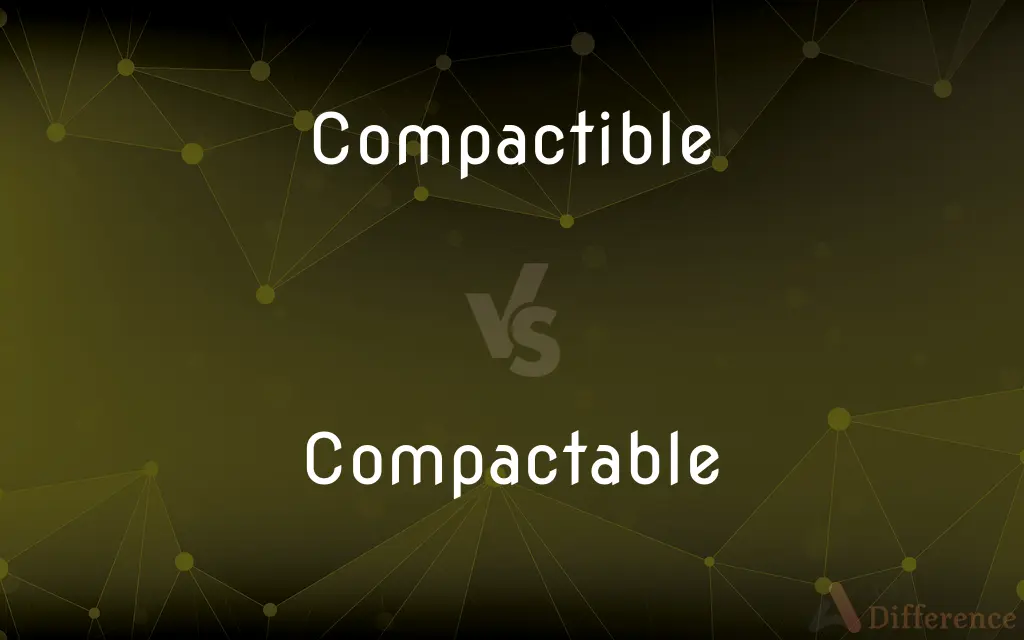Compactible vs. Compactable — What's the Difference?
By Urooj Arif & Fiza Rafique — Updated on March 26, 2024
Compactible refers to the ability to be compacted or compressed easily, focusing on the material's adaptability, whereas compactable emphasizes the capacity for compaction, often relating to soil or construction materials.

Difference Between Compactible and Compactable
Table of Contents
ADVERTISEMENT
Key Differences
Compactible materials are those that can undergo compression or consolidation, easily adapting to a smaller volume without losing their essential properties. This term often applies to a wide range of substances, including waste, recyclables, and certain types of soils. On the other hand, compactable materials are specifically highlighted in contexts like construction and engineering, where the ability to compact a material to a desired density and stability is crucial for foundational and structural integrity.
The distinction between compactible and compactable often lies in the context of use rather than the inherent characteristics of the materials. While compactible is a broader term that can apply to any material that can be made more dense, compactable is typically used in technical specifications and standards, especially in the construction industry, to describe materials that are suitable for achieving a specific compacted state.
In environmental science, compactible materials are significant for waste management and recycling processes, as reducing the volume of materials can lead to more efficient disposal and recycling methods. Conversely, in civil engineering, the focus on compactable materials is paramount for ensuring the ground or base materials are properly prepared to support buildings, roads, and other structures.
The compactibility of an item or material often refers to its physical property and tendency to be compressed, while compaction ability, or being compactable, may also take into account the method and equipment used to achieve the desired state. This implies that while many materials are inherently compactible due to their physical nature, not all may be considered compactable in specific engineering or construction contexts without the appropriate methods.
Comparison Chart
Definition
Able to be compacted or compressed easily
Suitable for compaction to a desired density and stability
ADVERTISEMENT
Primary Context
Broad, including waste and recyclables
Specific, often related to construction and civil engineering
Focus
Adaptability and volume reduction
Achieving structural integrity and stability
Example Materials
Waste, recyclables, soft soils
Gravel, soil, construction aggregates
Significance
Environmental efficiency in waste management
Foundational support in construction projects
Compare with Definitions
Compactible
Suitable for volume reduction.
Compactible waste bags are essential for efficient trash management.
Compactable
Evaluated for use in structural support.
Engineers test materials for compactable qualities in infrastructure projects.
Compactible
Beneficial for environmental practices.
Compactible containers reduce landfill space usage.
Compactable
Fit for compaction to achieve stability.
The compactable gravel provided a solid base for the driveway.
Compactible
Adaptable to smaller spaces.
The compactible clothing design saves suitcase space for travelers.
Compactable
Essential for engineering and construction projects.
Compactable aggregates are selected for their load-bearing capacity.
Compactible
Able to be compressed with ease.
The compactible nature of the foam makes it ideal for packaging.
Compactable
Meeting standards for construction compaction.
Compactable soil is a prerequisite for the building foundation.
Compactible
Responsive to compression efforts.
The soil's compactible quality allowed for easy garden bed preparation.
Compactable
Characterized by the ability to reach a desired density.
The road's subbase consists of compactable materials.
Compactible
Capable of being compacted.
Compactable
Capable of being compacted.
Compactible
That may be compacted.
Common Curiosities
What makes a material compactible?
A material is considered compactible if it can be easily compressed or condensed without significant degradation.
Can all compactible materials be used in construction?
Not all compactible materials are suitable for construction; compactable materials must meet specific density and stability requirements.
How does compactibility affect waste management?
Compactibility allows for more efficient waste management by reducing the volume of waste, facilitating easier disposal and recycling.
How do engineers test for compactability?
Engineers use tests like the Proctor compaction test to determine the moisture-density relationship and compactability of materials.
Are compactible materials environmentally friendly?
Compactible materials can be environmentally friendly if their compression leads to more efficient recycling or disposal methods.
What role does compactability play in road construction?
Compactability is crucial in road construction for creating a stable and durable base and subbase that can support traffic loads.
What determines if a soil is compactable for construction?
Soil's compactability for construction is determined by its composition, moisture content, and the compaction method used.
Why is compaction important in construction?
Compaction increases the density and stability of materials, essential for the structural integrity of construction projects.
What is the environmental impact of not compacting materials properly?
Improper compaction can lead to structural failures, increased environmental degradation, and inefficient use of space and resources.
Can compactibility vary between different types of the same material?
Yes, compactibility can vary based on the material's composition, granularity, and other physical properties.
How does the concept of compactibility relate to sustainable living?
Compactibility relates to sustainable living by promoting the efficient use of space and resources, reducing waste, and encouraging recycling efforts.
How does moisture affect the compactability of soil?
Moisture content significantly impacts soil compactability; too little or too much moisture can hinder achieving optimal density and stability.
Are there any standards for determining compactability?
Yes, there are industry standards and specifications that define the compactability criteria for various materials used in construction.
What are the challenges in compacting recyclable materials?
The main challenges include varying material properties, contamination levels, and the need for specialized equipment for different materials.
Why are compactable materials preferred in landfill operations?
Compactable materials are preferred in landfills to maximize space efficiency and stability, reducing the landfill's overall environmental footprint.
Share Your Discovery

Previous Comparison
Wasteland vs. Desolation
Next Comparison
Circuit vs. RouteAuthor Spotlight
Written by
Urooj ArifUrooj is a skilled content writer at Ask Difference, known for her exceptional ability to simplify complex topics into engaging and informative content. With a passion for research and a flair for clear, concise writing, she consistently delivers articles that resonate with our diverse audience.
Co-written by
Fiza RafiqueFiza Rafique is a skilled content writer at AskDifference.com, where she meticulously refines and enhances written pieces. Drawing from her vast editorial expertise, Fiza ensures clarity, accuracy, and precision in every article. Passionate about language, she continually seeks to elevate the quality of content for readers worldwide.















































